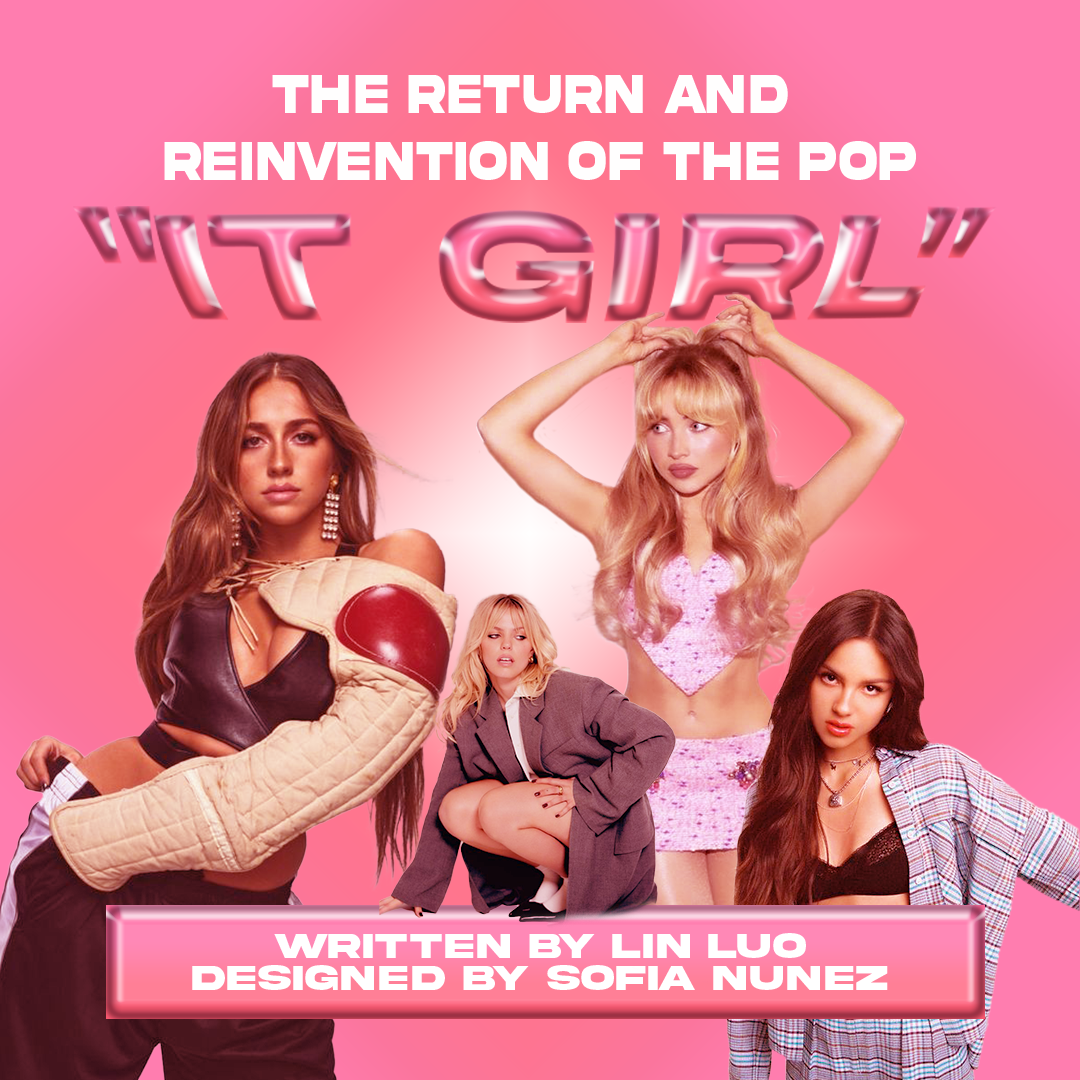
Pop “it girls” are making a comeback.
The feeling is nearly indescribable yet electrifyingly palpable. It’s in the air, akin to what the public felt as Leonardo da Vinci began to paint the Mona Lisa, marking the beginning of the Renaissance of the 15th and 16th centuries. Likewise, a pop renaissance is imminent. When the radios play Miley Cyrus’ middling tune “Flowers” there’s an intense longing for the greatness of pop-music past, a greatness that’s been historically fulfilled by female pop stars.
For much of our cultural consciousness, the concept of a “pop star” has remained constant. The Collins English Dictionary defines this term in the most vague sense possible, describing it as a “famous singer or musician who performs pop music.” The formal definition of “it girl,” courtesy of the Cambridge Dictionary, also leaves much to the imagination: “a famous young woman who is known for going to a lot of parties and social events.” With such loose definitions, we must turn to concrete examples to form our own definition: Britney Spears, Taylor Swift, Destiny’s Child and Selena Gomez to name a few.
With the beginning of 2024, it’s inarguable that the pop star concept has been reformulated to better suit our modern appetites. Featuring greater diversity and unapologetic celebrations of the feminine experience, the message is clear that there is a pop girl for everyone’s taste. Let’s take a look at just some of the options.
Sabrina Carpenter, often hailed among pop music stans as a “pop star Barbie,” has evolved over her decade in the industry from ukulele-driven woes of adolescent love to pure girlhood fun bottled in easily-digestible, less-than-three-minute songs. Reveling in her ultra femininity, seeing Carpenter live is like going to pop church. Tosses of her long blonde bombshell curls over her shoulder, twirls in her ultra-mini hemlines and struts across the stage in her 2000s-inspired white Go-Go boots have caused Carpenter to gain widespread comparisons to Bratz and Barbie dolls. As is what happens to most young women in the spotlight, Carpenter did face unwarranted hate as a product of industry peer Olivia Rodrigo’s breakout hit “drivers license.” Cruelly labeled a “slut” and “homewrecker” by media outlets, Carpenter successfully toyed with and redefined such derogatory labels, flipping the narrative to embrace the fact that she is bold, sexy and confident in her beauty. To be so content with her femininity and unafraid of her sexuality, Carpenter is truly an icon for the girls.
Chappell Roan’s debut album “The Rise and Fall of a Midwest Princess” is one of the most audacious, wondrously trashy projects in recent music memory — and we are so here for it. For a quick taste: Roan boasts to her love interest in “Red Wine Supernova,” “I heard you like magic / I’ve got a wand and a rabbit,” whereas her idea of an emotional hook from the slow ballad “Casual” bemoans “I fucked you in the bathroom when we went to dinner / Your parents at the table, you wonder why I’m bitter.” Her music details her personal evolution as she transitioned from her Midwest conservative background to the bold, unapologetically queer scene of Los Angeles drag culture, while her visual aesthetic draws much inspiration from drag looks. Roan has also turned her concerts into celebrations of drag, such as by featuring drag queens as openers on her “Naked in America” Tour. With the pop scene becoming oversaturated as every new artist fights to make their new single the next big TikTok trend, Roan belts a new life into the genre.
If you’ve had any access to a screen in the past couple of months then you know who Tate McRae is. Whether it be on TikTok where she has multiple viral hits (“greedy” and “exes,” to name a few) or at the NHL All-Star game where she absolutely killed her performance, it’s undeniable that McRae is here to stay. Her early work saw her being pushed as a Billie Eilish-like, sad-girl type singer, but with her recent album, “Think Later,” in the words of McRae herself, “sad girl bit got a little boring.” “Think Later” is anything but boring — her music videos emanate with her raw aura of brash confidence as she hair-flips and dances her way over the infectious beat. If such energy seems nostalgic, it’s because McRae draws great inspiration from early 2000s pop icons for both her stage presence and music videos, being hailed for bringing the art of magnetic choreography back to live performances as a result.
Reneé Rapp, with her alleged lack of media training and overall confidence in her openness, has been marked as an upcoming force to watch in the industry. Although the majority of her music is more of the mid-tempo, R&B production-style persuasion, it’s humorously juxtaposed with Rapp’s unhinged public persona. Bashing a bus driver for being “disrespectful and misogynistic” and even going so far as to poke fun at her reputation on Saturday Night Live as a “little lesbian intern” who’s been sentenced to “40 hours of court-ordered media training,” Rapp is honestly just a fun person to watch on social media. It’s refreshing to see a celebrity say what’s on their mind and not seem to care about what audiences or their management might think. Rapp may not be a “mean girl,” but she’s not trying to be nice — and that’s what makes her an icon, especially for the queer community.
With TikTok algorithms and new artists popping up on our feeds every day, the music industry has shifted in the past couple of years. Although we only covered a small portion of the wide-ranging female pop landscape, other standouts include PinkPantheress’ synthetic Jersey Club-like beats, Griff’s sad-girl gospels and FLO’s commitment to bringing back the pop girl group. Despite your taste, one thing’s for sure: the future of pop is in good hands.